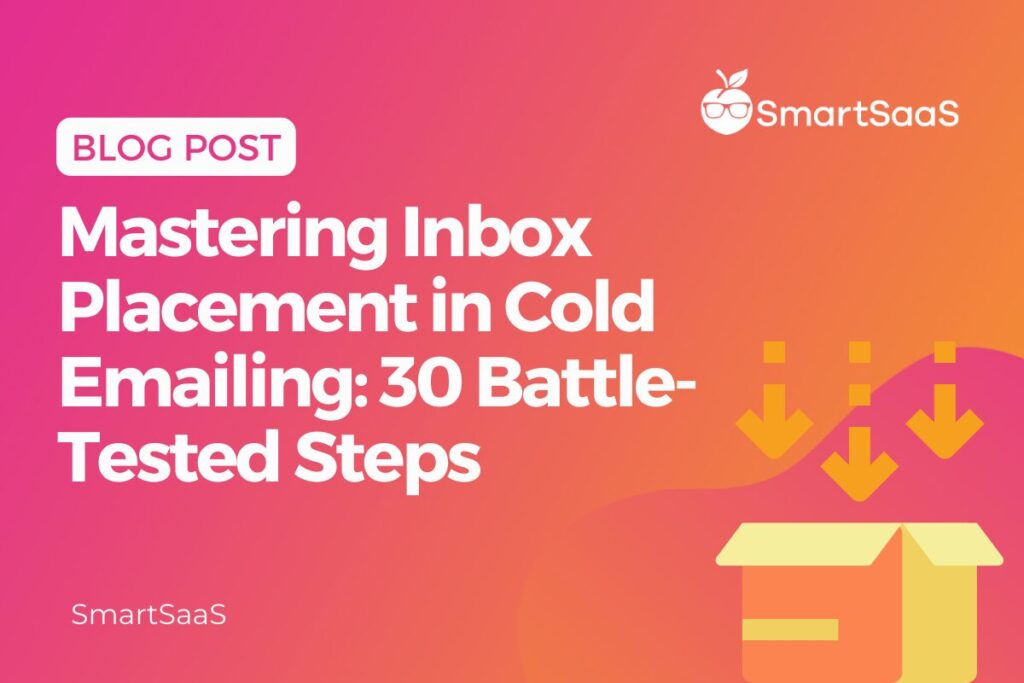7 Elements Influencing Your Sender Reputation and Ways to Enhance It

If you’re a business owner or a sales development representative, cold emailing is probably a staple in your day-to-day activities. But, have you considered how crucial your sender reputation is to the effectiveness of these email campaigns?
This article will delve into the seven key elements that influence your sender reputation and offer practical advice on enhancing it. This resource is designed for everyone from experienced email marketers to those just beginning. It aims to highlight the significance of maintaining a positive sender reputation and share methods to improve it.
1. IP address reputation
When sending emails, you must be aware of your IP address. Your IP address is is what identifies your device, enabling it to communicate on a network. In the context of email sending, your IP address is the address from which your emails are being sent.
However, it’s essential to understand that more than being aware of your IP address is needed. Be mindful of the possibility of your IP address being blocklisted. A blacklist is a real-time database of IP addresses or domains known to send spam or malicious content. If your IP address is blacklisted, it can significantly impact your email deliverability.
What Causes Blacklisting?
There are several reasons why an IP address might end up on a blacklist. Poor email list hygiene and spam complaints are the most common reasons. If you’re sending emails to invalid or inactive email addresses or sending emails to people who haven’t opted into your list, you’re more likely to end up on a blacklist. Similarly, if recipients mark your emails as spam, this can lead to blacklisting.
However, it’s also worth noting that a false positive is possible. Your IP address might end up on a blacklist even if you haven’t engaged in malicious or spammy behavior.
How to Avoid Blacklisting
The best way to avoid blocklisting is to practice good email list hygiene. This means regularly cleaning your email list to remove invalid or inactive email addresses and ensuring all recipients have opted in to receive your emails. Additionally, you should monitor your email-sending practices and ensure that you’re not engaging in any spammy behavior.
Another critical step is checking whether your IP address is on block lists. Several tools are available that allow you to do this quickly and easily. Regularly checking your IP address against blocklists ensures that your email campaigns aren’t being flagged as spam and are reaching your intended recipients’ inboxes.
2. Bounce rate
Cold emailing is essential for businesses to connect with their consumers and promote their products or services. However, if your emails are not reaching your subscribers’ inboxes, you miss out on potential leads and revenue. This is where the bounce rate comes in.
2. What is Bounce Rate?
Bounce rate is the percentage of email addresses in your email list that did not receive your message because a recipient mail server returned it. It is the number of emails that “bounce back” after you hit the send button.
Types of Bounce Emails
There are two types of bounce emails: hard bounce and soft bounce.
- Hard bounce: This type of bounce occurs when the email address is invalid or may not exist. It could be due to a misspelled email address or an address that was deleted or deactivated.
- Soft bounce: A soft bounce happens when the email is returned due to a temporary issue, such as a full inbox, server downtime, or technical issues with the mail server. In most cases, it is a problem at the side of your mail server or the hosting email server with an installed email client where you send emails.
Why Bounce Rate Matters
A high bounce rate can indicate poor email list hygiene, invalid email addresses, or technical issues with your cold email campaign. It can also impact your email deliverability and sender reputation, leading to your emails being marked as spam or blocklisted by email providers.
By monitoring your bounce rate, you can identify and address any issues affecting your email delivery and take steps to improve your email list quality and engagement rate.
Reducing Bounce Rate
Reducing your bounce rate requires a combination of good email list management practices, such as regularly cleaning your email list and removing invalid email addresses, and technical troubleshooting to identify and fix any issues with your cold email campaign.
By following these steps, your email deliverability will imrpove, increase engagement with your subscribers, and drive better results from your sales outreach.
3. Unsubscribe rate
One of the critical metrics that mailbox providers use to determine your email reputation is the unsubscribe rate. This metric measures the recipients who opt out of receiving your emails after receiving them.
While it may seem counterintuitive, a high unsubscribe rate can harm your email deliverability. When subscribers opt out of your emails, it signals to mailbox providers that your content is irrelevant to your audience.
The Importance of Relevant Content
One of the primary reasons why subscribers choose to unsubscribe is due to irrelevant content. If your emails are not tailored to your audience’s needs and interests, they will likely lose interest and opt out of future communications.
On the other hand, if you consistently deliver high-quality, relevant content that resonates with your audience, you are more likely to see higher engagement rates and lower unsubscribe rates.
The Role of Email Reputation
Your email reputation is critical in determining your deliverability rates. Mailbox providers use a range of factors to assess your importance, including your unsubscribe rate, spam complaint rate, and engagement metrics.
By providing valuable, relevant content to your subscribers, you can improve your email reputation and increase your chances of reaching your audience’s inbox.
By proactively improving your email deliverability, you can increase your chances of reaching your audience and achieving your marketing goals.
4. Complaint rate
The complaint rate in cold emailing is the number of times a recipient marks an email as spam or junk mail compared to the total number of emails sent. It measures how many recipients are unhappy with the content of the emails they are receiving and can negatively impact the sender’s reputation and deliverability. Maintaining a low complaint rate is crucial for a successful cold email outreach campaign.
Improve Email Reputation with Feedback Loops
One way to monitor and take care of complaints is to sign up for feedback loops (FBLs). A feedback loop is a system mailbox providers create to notify you when your subscribers report your message as spam. This is usually done by hitting the “report spam” button in that ISP’s mail interface.
By signing up for FBLs, you can immediately identify and clean your list of subscribers who do not wish to receive your emails. This helps to improve your email reputation and increase the probability of your emails reaching your subscribers’ inboxes.
How Feedback Loops Work
When you sign up for FBLs, you will receive notifications whenever a subscriber reports your message as spam. This notification provides you with the subscriber’s email address, who reported your message, and the reason for the complaint.
By having this information, you can quickly take action to remove this subscriber from your email list. This ensures that you only send emails to subscribers who want to hear from you, which is essential for maintaining a good email reputation.
The Benefits of Using Feedback Loops
- Improves email reputation
- Reduces complaints and spam reports
- Increases deliverability rates
- It helps you clean your email list
- Ensures that you are only sending emails to subscribers who want to hear from you
By promptly addressing complaints, you can improve your email deliverability rates and ensure that your emails reach the inboxes of subscribers who want to hear from you.
5. Spam trap hits
Spam traps are a significant concern for sales representatives doing cold email outreach as they can negatively influence deliverability. The reason behind this is simple: hitting a spam trap often results from failing to follow cold email best practices and not maintaining a clean and updated email list in particular.
Understanding Spam Traps
Before we delve into the impact of spam traps on deliverability, let’s first understand what spam traps are. Spam traps are email addresses not actively used by real people but instead created by ISPs and anti-spam organizations to catch spammers who send unsolicited emails.
There are three main types of spam traps:
- Recycled spam traps: These email addresses were once used by real people but have been abandoned for a long time, and ISPs have converted them into spam traps.
- Typo traps are email addresses created by intentionally misspelling popular domains such as Gmail, Yahoo, or Hotmail.
- Pure spam traps: Real people have never used these email addresses and are only created to catch spammers.
The Impact of Spam Traps on Deliverability
When your email hits a spam trap, it indicates to the ISPs that your email practices are not up to the mark, and you could be sending unsolicited emails. This can lead to being blocklisted or blocked by the ISPs, severely impacting your deliverability.
Furthermore, hitting a spam trap can also impact your sender reputation, which is critical in determining email deliverability. ISPs track your sender reputation based on various parameters such as the number of complaints, spam reports, and bounces. Hitting a spam trap can increase the number of complaints and spam reports, which can lower your sender reputation, and ultimately result in poor email deliverability.
Preventing Spam Traps
Following cold email best practices, including maintaining a clean and updated email list, is the best way to prevent spam traps. This includes regularly removing inactive or invalid email addresses, using double opt-in to verify subscribers, and segmenting your email list based on engagement.
Additionally, it’s essential to refrain from purchasing email lists or using outdated lists, as they often contain spam traps. Always use a reputable email service provider following industry standards and guidelines to ensure your emails are delivered to the inbox, not the spam folder.
Spam traps can severely impact email deliverability, and email marketers need to understand their significance and take necessary precautions to avoid them. By following cold emailing best practices and using a reputable email service provider, you can ensure your messages arrive to the inbox and not caught in spam traps.
6. Domain reputation
A critical aspect of email deliverability that is often overlooked is domain reputation. Like IP addresses, your domain also has its reputation calculated by every separate email receiver. Remember that if your IP reputation is high if your domain reputation is low, your emails may still have a high probability of ending up in a spam folder.
What is Domain Reputation?
Domain reputation is a measure of the trustworthiness of a domain name in email communications. It is calculated based on factors such as the quality of email content, sender authentication, and the sender’s email history.
When your domain reputation is high, email receivers trust your domain to send legitimate emails relevant to their interests. This, in turn, increases the chances of your emails reaching your subscribers’ inbox.
Why is Domain Reputation Important?
Domain reputation is crucial because it affects the deliverability of your emails. If your domain reputation is low, email receivers are more likely to mark your emails as spam, which can negatively impact your email deliverability. This can also lead to your domain being blocklisted, which can be challenging to reverse.
How to Improve Your Domain Reputation
- Send Relevant Emails: Ensure your emails are relevant to your subscribers and provide them with value. This will increase engagement and reduce the likelihood of them marking your emails as spam.
- Authenticate Your Emails: Use email authentication protocols such as SPF, DKIM, and DMARC to verify that your emails are legitimate and not spoofed.
- Monitor Your Sender Reputation: Keep a close eye on your sender reputation and address any issues that may arise promptly.
- Stay Compliant: Ensure your emails comply with email regulations such as GDPR and CAN-SPAM to avoid being marked as spam.
By improving your domain reputation, you can increase the deliverability of your emails and ensure that they reach your subscribers’ inboxes. Remember that email deliverability is a crucial factor in the success of your cold email outreach, so it is essential to take steps to maintain a good domain reputation.
7. Sending Frequency
In cold emailing, your sender reputation is crucial to your success. The more positive your reputation is, the more likely your emails will reach your intended recipients’ inboxes and not end up in the spam folder.
The Importance of Sending Frequency
One final determining factor of your sender reputation is your sending frequency. If you send too many emails quickly, your recipients may mark your emails as spam, which can damage your sender reputation.
On the other hand, if you send more emails, your recipients may remember you or lose interest in your content. This can also negatively impact your sender reputation. So, what’s the sweet spot?
Avoiding Spam Filters
By sending emails less frequently, you’ll also avoid triggering spam filters. Email providers use sophisticated algorithms to detect spam, and sending too many emails in a short period can set off these filters.
When your emails are flagged as spam, it may be challenging to regain your sender reputation. So, by sending emails once a week, you’ll not only keep your subscribers engaged, but you’ll also avoid the dreaded spam folder.
To Wrap Up
Having discussed the seven critical factors that can affect your sender reputation, it’s important to put these insights into practice. A strong reputation is key to ensuring your emails are received in the inbox, not relegated to the spam folder. Focusing on enhancing aspects like your IP address reputation, bounce rate, unsubscribe rate, complaint rate, spam trap hits, domain reputation, and sending frequency will help you gain your subscribers’ trust and improve your email deliverability.
It’s essential to understand that building a solid sender reputation is a process that requires time and dedicated effort. However, with appropriate strategies in place, your emails will more effectively reach your target audience and boost engagement.






Responses